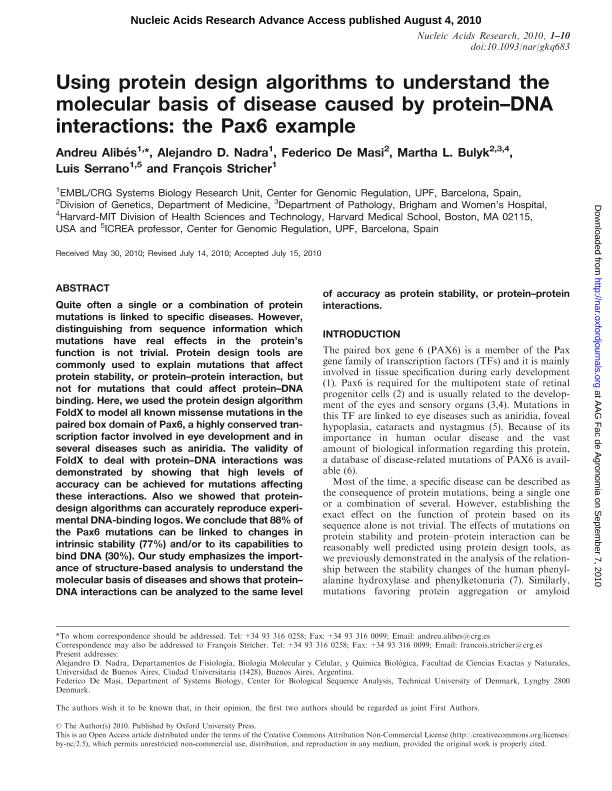Mostrar el registro sencillo del ítem
dc.contributor.author
Alibés, Andreu
dc.contributor.author
Nadra, Alejandro Daniel

dc.contributor.author
De Masi, Federico
dc.contributor.author
Bulyk, Martha L.
dc.contributor.author
Serrano, Luis
dc.contributor.author
Stricher, François
dc.date.available
2019-01-15T18:26:12Z
dc.date.issued
2010-11
dc.identifier.citation
Alibés, Andreu; Nadra, Alejandro Daniel; De Masi, Federico; Bulyk, Martha L.; Serrano, Luis; et al.; Using protein design algorithms to understand the molecular basis of disease caused by protein-DNA interactions: The Pax6 example; Oxford University Press; Nucleic Acids Research; 38; 21; 11-2010; 7422-7431
dc.identifier.issn
0305-1048
dc.identifier.uri
http://hdl.handle.net/11336/68053
dc.description.abstract
Quite often a single or a combination of protein mutations is linked to specific diseases. However, distinguishing from sequence information which mutations have real effects in the protein's function is not trivial. Protein design tools are commonly used to explain mutations that affect protein stability, or protein-protein interaction, but not for mutations that could affect protein-DNA binding. Here, we used the protein design algorithm FoldX to model all known missense mutations in the paired box domain of Pax6, a highly conserved transcription factor involved in eye development and in several diseases such as aniridia. The validity of FoldX to deal with protein-DNA interactions was demonstrated by showing that high levels of accuracy can be achieved for mutations affecting these interactions. Also we showed that protein-design algorithms can accurately reproduce experimental DNA-binding logos. We conclude that 88 of the Pax6 mutations can be linked to changes in intrinsic stability (77) and/or to its capabilities to bind DNA (30). Our study emphasizes the importance of structure-based analysis to understand the molecular basis of diseases and shows that protein-DNA interactions can be analyzed to the same level of accuracy as protein stability, or protein-protein interactions.
dc.format
application/pdf
dc.language.iso
eng
dc.publisher
Oxford University Press

dc.rights
info:eu-repo/semantics/openAccess
dc.rights.uri
https://creativecommons.org/licenses/by-nc-sa/2.5/ar/
dc.subject
Structure-Based Prediction
dc.subject
Protein-Dna
dc.subject
Pax-6
dc.subject
Foldx
dc.subject.classification
Otras Ciencias Biológicas

dc.subject.classification
Ciencias Biológicas

dc.subject.classification
CIENCIAS NATURALES Y EXACTAS

dc.title
Using protein design algorithms to understand the molecular basis of disease caused by protein-DNA interactions: The Pax6 example
dc.type
info:eu-repo/semantics/article
dc.type
info:ar-repo/semantics/artículo
dc.type
info:eu-repo/semantics/publishedVersion
dc.date.updated
2019-01-14T18:33:57Z
dc.identifier.eissn
1362-4962
dc.journal.volume
38
dc.journal.number
21
dc.journal.pagination
7422-7431
dc.journal.pais
Reino Unido

dc.journal.ciudad
Oxford
dc.description.fil
Fil: Alibés, Andreu. Universitat Pompeu Fabra; España
dc.description.fil
Fil: Nadra, Alejandro Daniel. Universitat Pompeu Fabra; España. Consejo Nacional de Investigaciones Científicas y Técnicas; Argentina
dc.description.fil
Fil: De Masi, Federico. Brigham and Women's Hospital; Estados Unidos
dc.description.fil
Fil: Bulyk, Martha L.. Brigham and Women's Hospital; Estados Unidos. Harvard Medical School; Estados Unidos
dc.description.fil
Fil: Serrano, Luis. Universitat Pompeu Fabra; España. Institució Catalana de Recerca i Estudis Avancats; España
dc.description.fil
Fil: Stricher, François. Universitat Pompeu Fabra; España
dc.journal.title
Nucleic Acids Research

dc.relation.alternativeid
info:eu-repo/semantics/altIdentifier/doi/http://dx.doi.org/10.1093/nar/gkq683
dc.relation.alternativeid
info:eu-repo/semantics/altIdentifier/url/https://academic.oup.com/nar/article/38/21/7422/2411827
Archivos asociados
